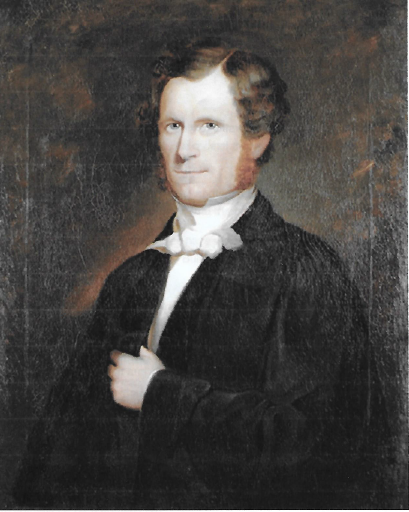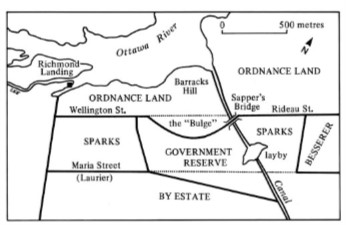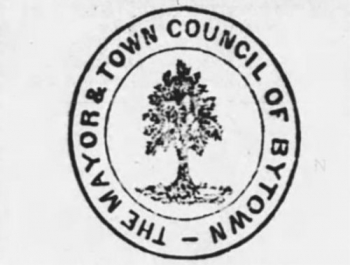28 July 1847
Municipal elections don’t get the respect they deserve in Canada. Invariably, far fewer people vote in them than they do in their provincial or federal counterparts. And Ottawa’s municipal elections are no exception. In the 2018 election, the percentage of registered voters who actually voted was less than 43 per cent. In comparison, two-thirds of registered Canadian voters exercised their franchise in the 2015 federal election. Reasons for municipal voters’ apathy include a lack of awareness about what local candidates stand for, and a feeling that municipal governments don’t matter very much. Two hundred years ago, the sentiment was very different. The quest for independent, municipal governments responsible to local ratepayers was a potent political issue that divided communities.
When British sympathizers fled northward following the American Revolution, they brought with them the democratic processes that they had grown up with in New York, Pennsylvania, and New England. These included elected municipal officials and town hall meetings where local issues were publicly thrashed out. For British military leaders in what was to become Canada, such democratic ideas were anathema. After all, hadn’t democracy led to the loss of the southern American colonies? In their view, free elections, even at the local level, threatened peace and order. What was needed was the firm guiding hand of Crown-appointed magistrates and officials.
In 1791, Quebec was divided into two parts under the Constitutional Act—Lower Canada where the French civil code and customs prevailed and Upper Canada where British common law and practices were introduced to accommodate the many English-speaking, United Empire Loyalists. However, General Simcoe, Upper Canada’s first lieutenant governor, was loath to permit democratic notions from taking root in Canada. He was appalled when one of the first acts of the Assembly of Upper Canada was to approve town meetings for the purpose of appointing local officials. He stalled and prevaricated, favouring instead a system of municipal government guided by justices of the peace appointed by the Crown. It took decades for real democracy to be introduced. In the interim, power at both the provincial and municipal level was tightly controlled by a small group of powerful merchants, lawyers and Church of England clergymen who became known as the Family Compact.
Cracks in this authoritarian structure began to show in 1832 when Brockville won the right to have an elected Board of Police. Other towns quickly followed suit. In 1834, the town of York became the city of Toronto under its radical first mayor William Lyon Mackenzie, and held direct elections for its mayor and its aldermen. In 1835, a new Act of the Provincial Assembly transferred municipal powers from the justices of the peace to elected Boards of Commissioners. However, this democratic reform was repealed amidst the Rebellions of 1838 by resurgent conservative forces who managed to frame the debate as between order and loyalty to the Crown on one side and disorder and republican disloyalty on the other.
This set the stage for Lord Durham’s famous investigation into the causes of the Rebellions and possible solutions. In his Report made public in 1839, Durham recommended the introduction of responsible government in Canada with ministers responsible to an elected assembly rather than appointed by the Crown. He also said that “the establishment of a good system of municipal institutions throughout the Province [Upper Canada] is a matter of vital importance. In 1841, the District Council Act was passed by Parliament. It was a compromise between conservative (Tory) forces that wanted to maintain central control over local affairs in order to ward off republicanism and radical (Reform) forces that wanted total local self-government. Districts would be governed by a warden appointed by the Crown and a body of elected councillors. While some municipal officials were appointed by the councillors, certain positions, including that of treasurer, would continue to be appointed by the Crown. It wasn’t until the “Baldwin Act” of 1849 (named for Robert Baldwin) that municipalities in Upper Canada were granted wide powers of self-administration.
The broad forces that were in play in Upper Canada were also in play in little Bytown which was established in 1826 by Lieutenant-Colonel By, the architect of the Rideau Canal. Initially, it was a military town where the British Ordnance Department was the dominant player in the local administration and a major landowner. In the 1830s, Bytown became part of Nepean Township and subsequently the “capital” of the Dalhousie District with an appointed warden. In addition to Bytown, other communities represented in Dalhousie District included Nepean, Gloucester, North Gower, Osgoode, Huntley, Goulbourn, Marlborough, March, Torbolton, and Fitzroy. It was a cumbersome arrangement owing to the size of the district and poor roads.
On 28 July 1847, Bytown gained new status when the Governor General gave his assent to “An Act to define the limits of the Town of Bytown, to establish a Town Council therein, and for other purposes.” Bytown was divided into three wards, with elections held in mid-September for seven town councillors—two from each of North and South Wards and three from West Ward. North and South Wards encompassed Lower Bytown, the home of mainly working class, Roman Catholic, Irish and French settlers. West Ward contained Upper Bytown, the smaller of the two Bytowns, and the home of the upper-class, Protestant, English elite. Given these demographics, Lower Town was broadly Reform territory, while Upper Town was a Tory bastion.
With eligible voters limited to male ratepayers, there weren’t many voters—only 878 men voted in that first Bytown election. Voting was also public. A secret ballot wasn’t introduced until the Baldwin Act was passed two years later. At the time, a secret ballot was widely perceived as being cowardly and a voting method that promoted political hypocrisy. Elected were Messrs. Bedard and Friel from North Ward, Messrs. Scott and Corcoran in South Ward and Messrs. Lewis, Sparks and Blasdell in West Ward. With the four elected from the North and South Wards all reformers, they held a narrow one-vote majority on Council over the three Tory victors elected in West Ward. At the first session of Council, John Scott was elected Bytown’s first mayor by the seven elected councillors who split down political lines: four Reformers versus three Tories.
 Portrait of John Scott, First Mayor of Bytown, 1848 by William Sawyer, City of Ottawa.In January 1848, John Scott was also elected to the Provincial Parliament as the member for Bytown—this was an era when politicians could hold multiple elected posts simultaneously. In the second municipal election held the following April, Scott chose not to run leading to the election of Tory John Bower Lewis as the second Mayor of Bytown. In 1849, fellow Tory, Robert Hervey, was chosen as Mayor.
Portrait of John Scott, First Mayor of Bytown, 1848 by William Sawyer, City of Ottawa.In January 1848, John Scott was also elected to the Provincial Parliament as the member for Bytown—this was an era when politicians could hold multiple elected posts simultaneously. In the second municipal election held the following April, Scott chose not to run leading to the election of Tory John Bower Lewis as the second Mayor of Bytown. In 1849, fellow Tory, Robert Hervey, was chosen as Mayor.
Hervey’s term in office was marred by two major political events—the Stony Monday riots in September 1849 in which Tories and Reformers came to blows, inflamed by Hervey’s own partisan actions and rhetoric, and the disallowance of the very Act of Parliament that had incorporated Bytown two years earlier.
The disallowance of the Act has its roots in a dispute between the Town Council and the Ordnance Department. Under its Act of Incorporation, Bytown had the right to expropriate land. Using this power, the Town Council expropriated a strip of Ordnance property along Wellington Street for the purpose of continuing the street “over the hill between the two towns to meet Rideau Street, in a direct line” at Sappers’ Bridge. At that time, Wellington Street made a bulge around the base of Barrick Hill (later known as Parliament Hill). But with the construction of Sparks Street immediately south of Wellington Street to Sappers’ Bridge following the settlement of another dispute over the ownership of the Government Reserve between Ordnance and Nicholas Sparks in Sparks’ favour, Town Council wanted to straighten Wellington Street. According to the Packet newspaper, the piece of land was “of no value” to the Ordnance Department but was “essential to preserve the uniformity of Wellington Street.”
The Town went ahead and straightened the street over the strenuous objections of the Ordnance Department. Ostensibly, Ordnance claimed that the property was necessary for possible future defensive works. The Packet thought the dispute was caused by the “avarice of one or two self-interested individuals” in Ordnance. In late September 1849, rumours started to circulate that the Home Government in London was about to overturn Bytown’s Act of Incorporation passed by the Canadian Parliament and assented to by the Governor General two years earlier. Fearing this possibility, Councillor Turgeon (a future Mayor of Bytown) proposed repealing the offending By-law that had expropriated the land.
It was to no avail. In late October, the hammer came down. Bytown’s Act of Incorporation was officially disallowed by the British Government in the name of Queen Victoria at the request of the Ordnance Department. Bytown’s politicians were thunderstruck. The news “occasioned no little hub-bub,” said the Packet. “The shock was a dreadful one.” Nobody knew what it meant practically. While “magisterial business” would devolve to the Dalhousie District magistrates, what about other business? Could Bytown pay its bills? What about staffing? The town was described as being in “a bad state” with everything “topsy-turvy.” The Packet fumed at the intrusion of the Home Government in London into a “parish,” i.e. local, matter, and darkly threatened it would be a new argument for the Annexationists (those who wanted the United States to annex Canada).
 Map of Ottawa, c. 1840 showing Ordnance land and Wellington Street. Nicholas Sparks, another major landowner, successfully fought the Ordnance Department for the return to him of the Government Reserve Land. This allowed for the development of Sparks street to Sappers’ Bridge by 1849. Taylor, John 1986. “Ottawa, An Illustrated History,” James Lorimer & Company, Toronto.To make matters worse, the Ordnance Department erected a fence across Wellington Street close to Barrick Hill blocking passage of residents to Sappers’ Bridge. Fortunately, there was an alternate route down Sparks Street. The Packet raised its rhetoric called the street closure “a petty act of tyranny inflicted on the habitants of our Town.” It added, “If anything was every calculated to create in the breasts of the inhabitants of this Town an indignant opposition to the British Crown, it is the blocking of one our principal streets.”
Map of Ottawa, c. 1840 showing Ordnance land and Wellington Street. Nicholas Sparks, another major landowner, successfully fought the Ordnance Department for the return to him of the Government Reserve Land. This allowed for the development of Sparks street to Sappers’ Bridge by 1849. Taylor, John 1986. “Ottawa, An Illustrated History,” James Lorimer & Company, Toronto.To make matters worse, the Ordnance Department erected a fence across Wellington Street close to Barrick Hill blocking passage of residents to Sappers’ Bridge. Fortunately, there was an alternate route down Sparks Street. The Packet raised its rhetoric called the street closure “a petty act of tyranny inflicted on the habitants of our Town.” It added, “If anything was every calculated to create in the breasts of the inhabitants of this Town an indignant opposition to the British Crown, it is the blocking of one our principal streets.”
Fortunately, municipal business was quickly regularized with the passage of the Baldwin Act, which allowed towns and cities to incorporate, and the holding of new Bytown Town Council elections in January 1850. With John Scott re-entering municipal politics and his election along with a majority of Reform councillors, Scott was re-elected Mayor of Bytown. Consequently, Scott has the honour of twice being the first Mayor of Bytown. The new Council presented “a humble Petition to the Master General and Board of Ordnance, praying that the Hon. Board may be pleased to grant the use of a space of land opposite Wellington Street to be used for street purposes.” Despite the begging, Ordnance refused to budge.
Residents began to wonder if there was something shady going on. One writer to the Packet in 1851 thought that the Corporation was conspiring in favour of Sparks Street merchants to keep traffic routed down this street rather than negotiating for the re-opening of Wellington Street. Finally, in June 1853, almost four years after the road was closed, Ordnance relented. But its terms were steep: the removal of the fence would be at Bytown’s expense; ownership of the strip of land would remain vested in Her Majesty; the road would be closed on May 1st every year to assert the Queen’s right; Bytown would pay a nominal rent of 5/- per year (5 shillings); no buildings could be erected on this strip of land; and Ordnance reserved the right to resume possession should it feel necessary to do so.
In time, the whole issue became moot when the Ordnance Department dropped its plans to fortify Barrick Hill. On January 1st, 1855, the City of Ottawa, formerly Bytown, was incorporated. One year later, under the Ordnance Lands Transfer Act, ownership of ordnance land in Bytown, and elsewhere, was transferred to the Province of Canada.
Sources:
Canada, Department of the Secretary of State, 1873. Report for the Year Ending 30 June 1873, Appendix A., Department of the Interior, Ordnance Lands Branch, Ottawa.
Durham, Lord, 1839. Report on British North America, Institute of Responsible Government, https://iorg.ca/ressource/lord-durhams-report-on-british-north-america/#.
Elections Canada, 2018. Estimation of Voter Turnout by Age Group and Gender at the 2015 General Election, http://www.elections.ca/content.aspx?section=res&dir=rec/part/estim/42ge&document=p1&lang=e#e1.
Mika, Nick & Helma, 1982. Bytown: The Early Days of Ottawa, Belleville: Mika Publishing Company.
Owens, Tyler, 2016. “A Mayor’s Life: John Scott, First Mayor of Bytown (1824-1857),” Bytown Pamphlet Series, No. 99, Historical Society of Ottawa.
Packet (The) & Weekly Commercial Gazette, 1847. “Prorogation of Parliament,” 31 July.
—————————————————–, 1847. “The Corporation Election.” 18 September.
—————————————————–, 1849. “Bytown Corporation,” 20 September.
—————————————————–, 1849. “The Town of Bytown,” 20 October.
—————————————————–, 1849. “The Ordnance Department And The People Of Bytown,” 13 November.
—————————————————–, 1849. “No Title,” 22 December.
—————————————————–, 1850. “The Elections,” 2 February.
—————————————————–, 1850. “Vote By Ballot, Etc.” 23 February.
—————————————————–, 1850. “Town Council Proceedings,” 23 February.
—————————————————–, 1851. “Queries Addressed To No One In Particular,” 21 June.
—————————————————–, 1853. “No Title,” 11 June.
Shortt, Adam & Doughty, A.G. Sir, 1914. Canada and its Provinces : a history of the Canadian people and their institutions, Volume 18, Toronto: Glasgow, Brook & Company.
Taylor, John H. 1986. Ottawa: An Illustrated History, Toronto: James Lorimer & Company.
Whan, Christopher, 2018, “Voter turnout for Ottawa’s municipal elections up from 2014,” Global News, 23 October.
Story written by James Powell, the author of the blog Today in Ottawa's History.
Retired from the Bank of Canada, James is the author or co-author of three books dealing with some aspect of Canadian history. These comprise: A History of the Canadian Dollar, 2005, Bank of Canada, The Bank of Canada of James Elliott Coyne: Challenges, Confrontation and Change,” 2009, Queen’s University Press, and with Jill Moxley, Faking It! A History of Counterfeiting in Canada, 2013, General Store Publishing House, Renfrew, Ontario. James is a Director of The Historical Society of Ottawa.






